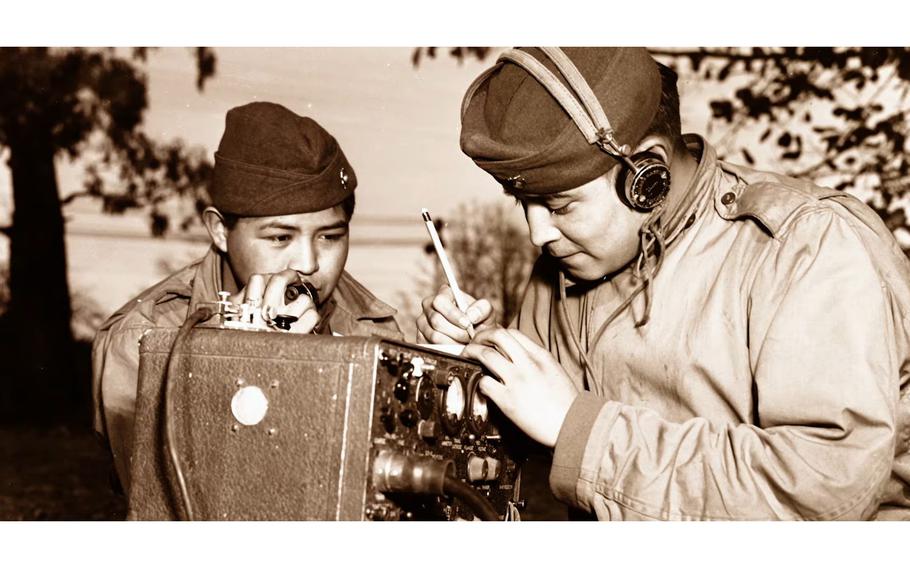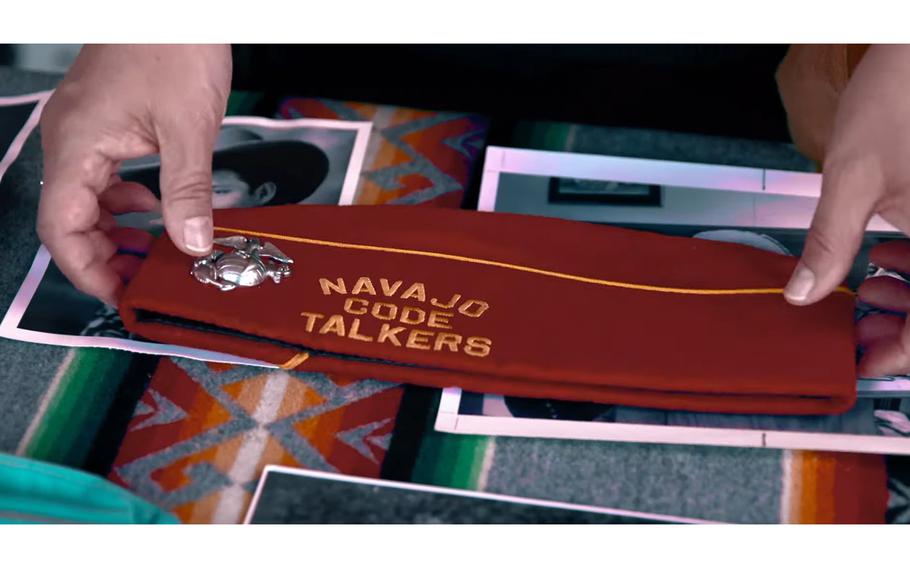
A video screen grab shows Navajo Code Talkers during World War II. (YouTube)
(Tribune News Service) — Zonnie Gorman grew up hearing her father’s stories about World War II and the work he did on the Pacific front. As she got older she realized his work was not only pivotal to the Allied victory but a testament to the ingenuity and bravery of the Navajo Nation men who were code talkers.
Zonnie’s father, Carl N. Gorman, was one of the original Navajo code talkers, also known as the first 29. The group of Navajo Marines developed a code for transmitting information back and forth to American troops based on the unwritten Navajo language.
Zonnie has dedicated her life to preserving the history of the Navajo code talkers. As one of the foremost experts on the matter, she was invited to speak at the Capitol Theatre for the Yakima Town Hall speaker series.
She delivered her lecture on Wednesday, where she shared her family’s history, the formation of the first 29 Navajo code talkers, their struggles to develop an efficient code and their eventual success.
In World War II, being able to send secret communications over communication mediums like radio was essential. Countries on both sides of the conflict rushed to develop and improve their encryption methods. The Wehrmacht had the Enigma machine, which eluded Allied forces for most of the war. Though the U.S. armed forces had similar cipher devices, they were bigger, bulkier and not fit for field use.
After the Japanese attack on Pearl Harbor, the U.S. was thrust into the war and the need for safe communication lines was immediate.
History
In her lecture, Zonnie separated the popular narrative, that Native Americans were first used to send encoded messages during World War II, from the historical fact that they had contributed to past war efforts in similar ways as far back as World War I.
“The U.S. Army had used Native people in World War I,” Zonnie said. “The Marine Corps however had never used a Native American language, so this was new to them. So they were a little apprehensive about it.”
Zonnie described the first time the Navajo language’s capacity for sending encoded messages was demonstrated.
Philip Johnston, a World War I veteran and civil engineer, spent most of his childhood living on the Navajo Reservation as the son of a missionary.
Not long after Pearl Harbor was bombed, he conceived the idea of the Navajo code talkers. Familiar with the tribe’s complex language and the need for secure military communications, Johnston took his idea to the Navy but eventually ended up presenting it to Gen. Clayton B. Vogel.
“Phillip Johnston found some Navajos that were living in Los Angeles at the time and he brought them to base,” Zonnie said. “What the Marine Corps did is they gave them some sample messages, very typical messages that would be sent in a war situation.”
The Navajo men were given a few minutes to go through the messages and fill in the gaps with replacement words where Navajo and English have none in common.
“We don’t have words for bombs, tanks, those kinds of things, so they needed to have something that they could use as a term for that,” Zonnie said.

A video screen grab shows a Navajo Code Talkers paraphernalia. (YouTube)
After the demonstration, Vogel wrote a two-page memo to the commandant of the Marine Corps, Lt. Gen. Alexander A. Vandegrift. The memo expressed full support of the Navajo men and their ability to serve the Marine Corps.
Program begins
On April 6, the Marine Corps officially began the Navajo code talkers pilot program. Though Vogel recommended 200 Navajo men be recruited for the effort, Marine Corps leadership decided to start with 30 instead.
Zonnie said it was around this time her father was recruited to the program. He told her a Navajo man approached Carl and his friends with information about the U.S. armed forces seeking Navajo men for a special assignment.
“My dad and his buddies, they kind of talked about it and said ‘Maybe we’ll get one of those nice uniforms and we’ll get new shoes and three square meals a day,’ “ Zonnie said.
Carl responded to the call and days later, was sent to San Diego for boot camp, along with the other 28 Navajo recruits. The 30th recruit, Zonnie discovered in her research, was a man who did not show up the day the code talkers were transported to California.
The 29 recruits became the 382nd Platoon, the first all-Native American platoon in the history of the Marine Corps.
Seven weeks later, after having exceeded expectations for their performance, all 29 recruits graduated from boot camp, an anomaly in the Marine Corps, where even to this day, about 10% of recruits do not make it through boot camp.
It wasn’t until after boot camp that the men learned about the nature of their recruitment.
While most accounts of this part of their story say the recruits agreed and began developing the code, Zonnie said some concerns led to in-depth conversations among the 29 men about using their language. As one of the most coveted cultural touchstones in any society, language can define a culture.
Using the language in war and imbuing it with filler words for the purposes of developing the code, was something all recruits had to agree on.
“It wasn’t just ‘oh yeah sure, we’ll make a code.’” Zonnie said. “It was a lot of thought and a lot of consideration from a cultural perspective about what they did. A lot more than what the popular narrative gives them credit for.”
After developing the code, which required a high-level understanding of both English and Navajo, the first 29 went on to prove the success of their methods on the Pacific front.
By the end of the war in 1945, there were more than 400 Navajo code talkers serving in the Marine Corps.
Their skills were employed across dozens of battles including those at Gudalcanal, Saipan, Guam and Iwo Jima. Decades later in 1968, the Navajo code talker program would be declassified by the federal government.
In 2001, the original 29 code talkers were awarded Congressional Gold Medals and the other hundreds of code talkers that followed received a silver medal, according to the National Archives.
Santiago Ochoa’s reporting for the Yakima Herald-Republic is possible with support from Report for America and community members through the Yakima Valley Community Fund. For information on republishing, email news@yakimaherald.com.
(c)2024 Yakima Herald-Republic (Yakima, Wash.)
Visit Yakima Herald-Republic
Distributed by Tribune Content Agency, LLC.